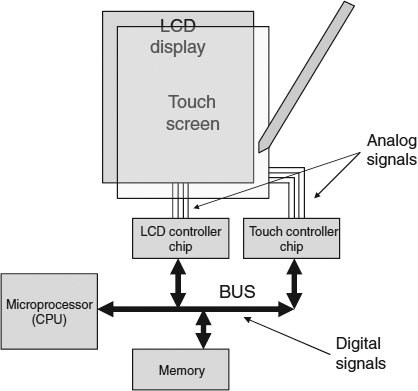10.3 INTERFACE LAYER
The interface layer is what enables the electronic signals in our interface devices to be understood by the software services layer. Any interface device is supported by a silicon chip device that handles electronic signals, usually analog, to and from transducers and electro-mechanical or electrophysical components.
What we eventually want is for our services software to be able to drive interface devices or to respond to their outputs in response to stimuli from the outside world, usually due to human interaction. The controller chips that control the interface devices can be controlled using low-level digital commands issued from a microprocessor or similar, such as a microcontroller or general-purpose DSP device. This would usually be the same processor that runs our services layer. Each controller chip, such as a controller for a LCD display, has its own specific set of commands that it will respond to via its microprocessor interface; this interface is usually referred to as a bus, as shown in Figure 10.5.

Figure 10.5 Microprocessor interface to interface peripherals.
The microprocessor will run all, or most, of the custom software on our mobile device. There may well be an additional processor to carry out any DSP functions, such as speech processing. We shall be looking at possible mobile device architectures later, but for now our concern is with the ...
Get Next Generation Wireless Applications: Creating Mobile Applications in a Web 2.0 and Mobile 2.0 World, 2nd Edition now with the O’Reilly learning platform.
O’Reilly members experience books, live events, courses curated by job role, and more from O’Reilly and nearly 200 top publishers.

